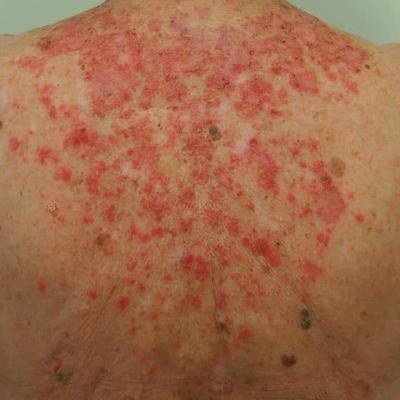Thalidomide for Recalcitrant Cutaneous Lupus Erythematosus
Recalcitrant cutaneous lupus erythematosus (CLE) causes patients considerable discomfort and often leads to disfigurement. Although the majority of CLE responds to the combination of sun protection, local glucocorticoids, and antimalarials, some cases require more aggressive therapy. Thalidomide (Thalomid® - Celgene Corporation) is a powerful option for treating recalcitrant CLE. Numerous clinical studies have demonstrated thalidomide's value as monotherapy in treating all forms of cutaneous lupus. In 1975, Rubio and Gonzalez first used it in chronic cutaneous lupus erythematosus (CCLE), and numerous subsequent studies corroborated its prompt effectiveness in antimalarial-resistant and topical-steroid-resistant lesions of CCLE. Further studies have shown equal effectiveness in subacute cutaneous lupus erythematosus (SCLE). In all of the aforementioned studies, participating patients were refractory to previous treatment (topical steroids and antimalarials, and often other therapies as well), and, in nearly all, patients achieved responses and were able to discontinue all medications previously required to control their cutaneous disease. Doses ranged from 50 mg to 400 mg daily, and maintenance doses ranged from 25 mg to 100 mg QD. Clearly, except for oral glucocorticoids, few if any other therapies offer such efficacy in treating CLE.
Why is such an effective treatment not utilized more frequently by clinicians? Side effects of thalidomide treatment are common and may be serious. Somnolence is perhaps the most common side effect and a frequent cause of treatment discontinuation. Initially marketed as a sedative, thalidomide has been reported to cause drowsiness in anywhere from 50% to 100% of patients. The effect may be overcome by lowering the dosage, and tolerance usually develops over time. Constipation and abdominal distention are other frequent complaints. In their study of 23 patients with cutaneous lupus, Atra and Sato noted constipation or abdominal distention in 22% of their patients. However, lowering the drug's dosage adequately controlled side effects. Other side effects less commonly reported include dry mouth, urticaria, rash, mood changes, circulatory changes, amenorrhea, edema, dizziness, and galactorrhea.
Thalidomide's most serious side effects are peripheral neuropathy and teratogenicity. Peripheral neuropathy is a common side effect of thalidomide treatment and maybe both severe and irreversible. Although usually sensory, neuropathy may involve motor roots as well. It usually appears after months of chronic use of thalidomide. Although some studies have debated this, several studies have linked it with cumulative dose, citing 40 mg to 50 g as the dose after which neuropathy usually becomes apparent. Incidence varies widely and may depend on the age of the patient (older patients seem to be more prone to neuropathy), sex (females are more prone), the presence of pre-existing neurologic disease, and the disease being treated. Reported incidence varies from 1% to 70%. Recovery may be slow or fail to occur: one study estimated that 4 to 6 years after treatment, 25% of patients had a full recovery, 25% had some improvement, and 50% had no change.
The drug's most infamous side effect is its teratogenicity. Phocomelia and death to the fetus are most common, although others have been reported to occur concurrently, including deformities of the internal organs. The incidence of birth defects is highest during the critical period of pregnancy, from 35 to 50 days after the last menstrual period, and even one 50 mg tablet ingested during this period is sufficient to produce devastating effects. Because of the seriousness of these effects, Celgene Corporation has gone to great lengths, with the development of the System for Thalidomide Education and Prescribing Safety (STEPS) program, to ensure no woman becomes pregnant while taking this medication. Physicians and pharmacies must be certified to prescribe this medication, patients must use 2 methods of birth control, and serum pregnancy tests must be performed biweekly to monthly. Such stringent prescribing restrictions and regulations have caused some clinicians to shy away from the use of this medication.
Recent reports in the oncology literature have definitively shown an association between thalidomide use and thromboembolic events, including deep vein thrombosis and pulmonary embolism. It appears that this dangerous side effect may not be limited to cancer patients treated with thalidomide. In our practice, 6 of 29 patients (20.7%) developed significant thromboembolic events while on thalidomide therapy for cutaneous lupus (4 patients) or Behçet's disease (2 patients) (unpublished data). Although these diseases both have a higher background incidence of thrombosis, our experience appears to confirm that thrombosis should be added to the list of potentially worrisome side effects caused by thalidomide. Care should be taken to avoid other risk factors for thrombosis in patients who are treated with thalidomide (eg, smoking, estrogen use).
The obvious dilemma is how to safely utilize this extremely efficacious medication yet minimize the risk of toxicity. The answer is by using as low a dose for as short a time as is possible. We routinely treat patients with recalcitrant CLE with short "pulse" courses of low-dose thalidomide as induction therapy. A typical patient begins treatment with 50 mg to 100 mg nightly. If the patient is not already on combination antimalarial therapy with hydroxychloroquine and quinacrine, these drugs are started concomitantly. The thalidomide dose is halved as soon as the patient shows a good response (typically between 2 weeks and 2 months) and is discontinued as soon as the skin is clear (typically 2 months to 5 months). It is imperative that the patient remains on antimalarials as maintenance therapy since up to 75% of patients relapse following discontinuation of thalidomide when it is used as monotherapy.4-6 It is possible to perform additional pulses if relapses recur (ie, each summer, after substantial sun exposure).
In summary, thalidomide is an extremely efficacious drug, yet healthy respect for its potential adverse events is required. We have found that short courses of thalidomide added to patients' previous treatment regimens induce rapid, complete, and long-lasting remissions while minimizing patients' risk of dangerous side effects.

